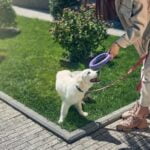Introduction
There are a number of benefits to teaching your dog to like water. Dogs that feel comfortable and confident around water are able to experience many thrilling activities with their owners such as swimming, dock diving, or participating in canine educations courses that involve body contact exercises with water. Not only will your pooch enjoy the companionship of a day out on the lake, but it will give them an additional exercise opportunity and a great way to socialize.
In addition to providing enjoyable activities for your furry friend, being comfortable in the water can also help them stay safe. If you find yourself in an aquatic emergency, your dog’s familiarity and comfort level around water could be vital their ability to make it safely back home. Furthermore, many people find they do not understand how much energy is needed for dogs to keep themselves afloat if required (especially breeds with short legs), therefore teaching them efficiently how to swim could prove incredibly beneficial should they ever inadvertently find themselves in troublesome waters.
Preparing You and Your Dog for Water Training
When training your dog to like water, it is important that you properly prepare yourself and your pup first. This means ensuring the safety of both of you when in or near water. When selecting a body of water for training, whether it be a lake, pool, or pond, pick one that does not go too far above your waist and make sure you are able to touch bottom. You may also want to wear a personal flotation device to add an extra layer of security; if needed, give one to your pup as well. Additionally, make sure there are no aggressive creatures in the area that pose a threat to you or your pet.
In terms of supplies for these sessions, bring along plenty of treats as rewards for positive reinforcement and a long leash so you can stay within reach while allowing enough slack that your pup still feels independent. An attached extended leash – similar to a retractable but without the action of retraction – can also work great here; this way you can add extra range while maintaining control. Finally, consider purchasing some puncture-resistant dog water shoes to protect sensitive paws from rocky terrain beneath the surface.
Stimulating a Positive Environment
When you begin teaching your dog to like water, it’s important to make the environment supportive and positive. Instead of forcing them into a situation where they will be uncomfortable, provide plenty of opportunities for fun and relaxation. Allow your dog to explore their new surroundings in an encouraging manner. Avoid making quick movements or any sudden noises that could startle them and make sure that all interactions are gentle, as this kind of behavior can cause stress levels to increase. Take the time to slowly introduce your pet to the water – place inviting toys at different depths along with treats so they can become accustomed slowly. Additionally, playing games with your pup such as fetching a floating toy in the pool or pond is a great way for your furry friend to learn how exciting being near or even in the water can be!
Introducing Different Types of Water to Your Dog
When training your dog to like water, it is important to introduce them to different types of water in stages. Start by teaching your dog to become comfortable with shallow water, such as a kiddie pool or even a shallow bathtub. Fill the bathtub up with an inch of water and let your dog explore it for awhile. Place his favorite toys inside the tub so that he can stay occupied and distracted, and let him get familiar with the feel of the water on his paws. If your dog appears at ease and ready for more, you can add more inches of water until it’s up to his chest level. Make sure you reward your pup after each successful step, either with treats or verbal praises, because this will create positive associations between the water experiences and receiving rewards. Gradually move deeper into ocean waves or lakes, which requires extensive training but will let him start developing stronger swimming skills over time. With patience, kindness, and plenty of rewards – including vocal praises – your dog should eventually become a proficient swimmer who isn’t afraid (or even dislike) playing in the waters!
Conditioning Your Dog to Water
The key to conditioning your dog to water is to start slowly and gradually build up their exposure and experience with it. Start by introducing your pup to the sight and sound of water, like letting them watch you take a shower or fill up a bucket. Talk to them calmly and keep the atmosphere relaxed.
Once they’re becoming more comfortable around the water, work on desensitizing them by wetting their coat or paws with a damp sponge. Reward your pup for being cooperative and brave – treats, praise, or even soothing head scratches are great motivators!
Once your pup is used to this, try taking short trips to shallow waters like calm streams and creeks that don’t have strong currents or heavy surf. With each new experience, reward them for good behavior so they’ll associate the water with positive experiences. If possible, stay in areas where other animals are swimming – this will help your pooch feel at ease in its new environment as it takes in all these new sights, sounds and smells.
In addition to gradually increasing exposure time in the water, it’s also an effective idea to use play time as a way of teaching your dog how much fun it can be playing in the pool or the lake. Bring some of their favorite toys along for the adventure – balls, fetch items and tougher chew toys all make great choices for motivated pups that want something extra special to swim after. As always, use positive reinforcement when working with any type of training – offer praise and rewards when they get close to achieving goals so they know they’re doing something right!
Designing a Reward System for Water-Related Behaviors
When training your dog to like water, it is important to create a reward system that reinforces healthy and positive behaviors. This can include verbal praise, treats, toys, or other rewards whenever the pup engages in a water related activity such as playing in the pool or going for a swim. It is also important to keep these rewards consistent so your puppy recognizes them and begin to associate water with fun and happiness. When introducing your pup to the pool, start by luring them close with treats or toys. Let them explore around on their own terms before attempting to get them into the water itself. You might try tossing a ball into shallow areas of the pool for them to fetch as starts off their experience with water play. Over time you can slowly introduce them to deeper sections of the pool but always make sure they are comfortable before taking next steps. Finally, don’t forget to vocalize your joy when they demonstrate mastery over this new skill as this can increase their chances of wanting to return for more fun!
Practicing Water Training With Your Dog
If you want your dog to be comfortable and confident around water, it’s important to train them properly. Start by letting your dog explore a splash pool, lake or creek. Give them treats and praise frequently for staying near the water’s edge. When they take their first few steps into the water, make sure to reward them with lots of encouragement.
Once your dog is comfortable at the water’s edge, you can start introducing activities like swimming and retrieving. Begin by playing fetch games in shallow waters where your pup’s feet are touching the ground. Gradually move farther out into the water as their confidence increases. A lifejacket can be used at this stage if needed to provide additional support for your pup’s safety.
You may also want to teach your dog how to enter water from a dock or boat ramp by having a family member stand near the shoreline offering verbal cues and treats while gently encouraging them forward with a favorite toy or stick. This exercise should always be done with close supervision in order ensure that they don’t jump into deeper waters too quickly as they gain confidence in their new-found skills.
Finally, allow plenty of time for fun activities on shore such as running after sticks and chasing balls so that they don’t become hesitant around large bodies of water in future encounters
Equipping Your Dog with the Necessary Survival Skills
One of the most important survival skills you can teach your dog is an understanding of basic water safety. Even if they don’t enjoy jumping in, it’s important to provide them with an understanding of how to interact safely around bodies of water. Start by introducing your pup or dog to shallow water on a hot day when they might eagerly jump in as an escape from the heat. Guide them along the shoreline and give them encouraging words as you do so. Make sure you fit your dog with a personal flotation device that fits properly and securely, and is designed for dogs.
It’s also important to consider any potential hazards that may be present at different bodies of water. Wherever you may take your dog, stay away from areas with alligators, dangerous currents, brush piles or debris that could cause entrapment, cliff edges and other unknown dangers. Make it safer for your pup by having them wear something bright so they are easily seen both in low light settings and out on the open water. Additionally, remain vigilant when taking your pet on the boat by never leaving their side while they explore deck space and keeping them safely secured while under way. Lastly, remind yourself that even the best swimmers need breaks during long periods in open waters –ensure their tails are still wagging before moving forward during extended boating trips!
Taking it to the Next Level
Once your pup is comfortable around water, you can start taking them out on the water with you. This is a great way to bond with your furry companion and deepen their aquatic adventure. Start by taking them out in a boat or kayak and then slowly progress to bigger bodies of water like lakes, rivers, or even the ocean. Provide plenty of treats and praise throughout the experience to keep them motivated and enjoying the time together. Be sure to bring all necessary safety equipment, including a floatation device for your pup and an emergency plan in case things go awry. If your dog shows any signs of discomfort or fear, take it slow and let them become accustomed to the activity at their own pace. With patience and consistency, over time you will foster an active relationship with the sea together!
Conclusion
Training your dog to like swimming can be a slow process. Start by introducing them to shallow bodies of water, such as an inflatable pool or shallow creek, to ease them into the experience without overwhelming them. Offer praise and treats after each visit to create positive reinforcement. When it’s time for deep-water swimming, secure a flotation device on your pup that offers support in the water. If you have access to a body of water specifically for dogs, take them there and let them explore at their own pace.
When making attempts to train your pup to swim, safety should always be top priority. Keep close watch over your pup when they are in the water and be ready to jump in if necessary. Depending on the complexity of their issue with water, multiple visits may be needed before your pup is ready for deep swimming or left alone around bodies of water. Ultimately though, patience and consistent positive reinforcement will make all the difference between a fearful pup and one who loves swimming!

Welcome to the blog! I am a professional dog trainer and have been working with dogs for many years. In this blog, I will be discussing various topics related to dog training, including tips, tricks, and advice. I hope you find this information helpful and informative. Thanks for reading!





